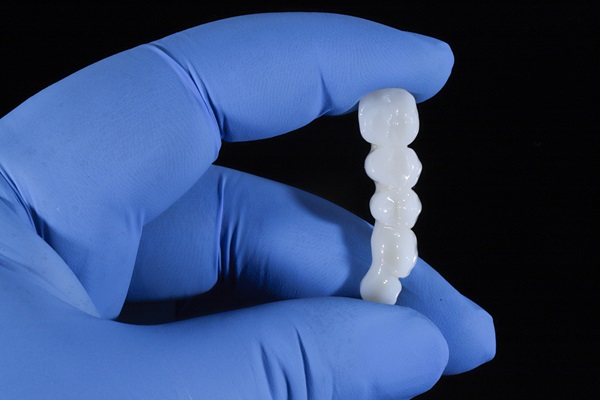Understanding the Process for Dental Bridges

Dental bridges are oral prosthetics designed to bridge the gap left behind by a missing tooth. Their primary aim is to restore the appearance and function of a smile. Partnering with a general dentist can help you reap the benefits of these prosthetics in two appointments.
What are dental bridges?
Dental bridges consist of one or more prosthetic teeth, known as pontics, anchored by dental crowns placed on the adjacent teeth. These supporting teeth, called abutment teeth, serve as a foundation for the bridge, ensuring stability and comfort. Dental bridges typically comprise durable materials such as porcelain, ceramic, or metal, designed to blend seamlessly with natural teeth.
Dental bridges not only improve the appearance of a patient's smile but also prevent neighboring teeth from shifting, preserve facial structure, and restore normal speech and chewing function. Further, they can replace up to four consecutive missing teeth.
The dental bridge process
The dental bridge process requires two appointments. The first involves preparing the abutment teeth, gathering the necessary measurements for the dental bridge, and placing a temporary bridge. The second will involve bonding the permanent dental bridge and making minor adjustments if necessary.
To start, the dentist will employ a local anesthetic to prevent discomfort during the procedure. Depending on how many abutment teeth will be necessary to help the bridge span (one or two), the dentist will prepare them by shaving and shaping them to ensure the crowns fit snugly. Next, they will take a mold or use 3D imaging to gain measurements of the space and size of the abutment teeth before sending the information to an outside lab. Finishing the appointment, the dentist will place a temporary bridge over the recently treated space to prevent pain while eating and drinking and allow for proper oral function.
Approximately two weeks later, the patient will return to the office for the second appointment. The dentist will remove the temporary bridge, which should not be painful. However, they may also test the abutment teeth to ensure they are still "alive," meaning the nerves are in working order and blood is still flowing through the tooth. This portion may be discomforting, but only for a few seconds. Next, the dentist will test the fit of the dental bridge without bonding it into place, making minor adjustments if necessary. Once happy with the fit, they will bond it into position using a special dental cement.
Caring for dental bridges
Proper care for a dental bridge is essential to maintaining its longevity and functionality. Following the first 48 hours of the procedure, patients must avoid flossing near their dental bridges to prevent dislodging. During this timeframe, they should also avoid tough, sticky, or chewy foods.
Following the first two days, patients should brush twice daily and floss around the bridge to prevent plaque buildup, as trapped food particles can lead to decay in the abutment teeth. Using a floss threader or interdental brush can help clean under and around the bridge. Regular dental check-ups are crucial for monitoring the bridge's condition and ensuring that the surrounding teeth and gums remain healthy. Further, a balanced diet, avoiding overly hard or sticky foods, helps reduce stress on the bridge and minimizes the risk of damage. According to the Cleveland Clinic, dental bridges can last up to 15 years with consistent oral hygiene and care, maintaining function and appearance.
Contact Michiana Family Dental to replace missing teeth
The process for dental bridges is straightforward, with each step designed to ensure a comfortable, well-fitting, and long-lasting prosthetic. By restoring function, appearance, and oral health, dental bridges are an effective restorative option for patients with missing teeth. If you are missing one or multiple teeth, contact Michiana Family Dental to schedule an appointment.
Request an appointment here: https://www.michianafamilydental.com or call Michiana Family Dental at (574) 349-2073 for an appointment in our South Bend office.
Check out what others are saying about our dental services on Google: Dental Bridges in South Bend, IN.
Recent Posts
A traditional dental bridge can replace up to three or four consecutive teeth on the same side of a dental arch. It is one of the most common dental replacements you can get. Knowing how to care for it can help maintain your new smile for a long time. Here are some tips for ensuring…
Dental bridges are one of the top solutions to get back your smile after losing one or multiple teeth. Patients everywhere need tooth replacement due to a variety of reasons. Seeing your dentist regularly is the most effective way to prevent the loss of teeth. Your oral hygiene should be a number one priority in your…
In dentistry, a dental bridge is one of the popular options for closing the gap left by a lost or extracted tooth. Bridges are typically made up of crowns on the sides of the gap, which cover adjacent health teeth, called the abutment teeth. These teeth support the replacement teeth, which could be one or…
A dental crown is used to restore teeth that are in bad shape. Oftentimes, they are needed for teeth that have become cracked, chipped or broken. Additionally, general dentists recommend them for teeth that have severely decayed due to an infection. While they are one of the most common dental restorations, many wonder how long…


